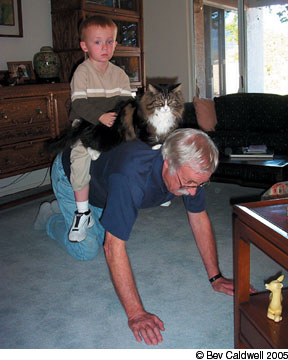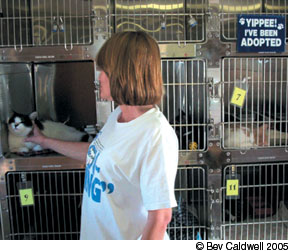Cassie, a female tabby cat blind from birth, arrived at the Best Friends Animal Society in Kanab, Utah when she was 15 years old. She had lived her entire life in Orange County, California with an elderly woman. When her caretaker died, Cassie ended up in a local animal shelter. Due to her age and assumed disability, she was slated to be euthanized when a rescue group stepped in and saved her. In time, she came to the sanctuary at Best Friends.

288
I was always drawn to Cassie – her spirit and presence – and felt that she not only deserved but could be placed in a good home, says Lezlie Sage, cat adoption coordinator at Best Friends.
Two years went by and no adoptive parents came forward, Sage recalls. Then one day a potential adopter called up to say, I saw Cassie on your website, and Id like to give her a second chance.
Cassies new human companion kept her promise. We frequently get photo updates of Cassies second chance in Twin Falls, Idaho, including supervised ventures outside and lots of lap shots, Sage says. She is 19 and a half years old now. She has touched not only me and her caregivers here at the sanctuary, but her new mom as well. She has been so taken by Cassie that she is now studying to become a veterinarian.
Arent They Cute?
Kittens will always be irresistible to cat lovers – their upfront antics and adorable looks draw attention at animal shelters, and they are frequently adopted quickly. Choosing to adopt an adult shelter cat instead of a kitten, however, has its own set of benefits and blessings.
The primary advantage is that you know what youre getting yourself into, Sage notes. A kittens personality is still developing, and it is very hard to guess what the ultimate demeanor will turn out to be. Conversely, an adult cat will show you who he is with very few surprises. If you want a laid-back lap cat, youll be able to recognize him straightaway, she says.
In addition, adult shelter cats usually have had medical exams, are spayed or neutered, are up to date on vaccinations and may even be microchipped – all for a nominal fee.
Choosing an adult cat who adapts well to your family and lifestyle can make the transition into your home easier, but adopting a grown-up cat can prove meaningful on other levels as well. Here at Best Friends we believe that every life counts, Sage says. The biggest challenge is to find the perfect match from both personality and environmental viewpoints, she emphasizes.
Best Friends finds permanent, loving homes for hundreds of adult cats each year, including many special needs cats. Like Cassie, these adoptions are extremely rewarding, she says.
Whether you choose a young adult cat or a special-needs senior, patience and understanding are the keys to bringing your cat home. The ability to adapt to a new home has less to do with age and more to do with individual temperament and life experience, Sage says. Some adults are very personable and fit in immediately, while others may be reticent based on inherent nature, past experiences and abandonment, she explains.

288
It is hard to say how long an adjustment will take, but it cant be rushed, she says. We encourage people to have faith that it will happen, and it usually does.
Its not unusual for shelter cats to feel anxious or afraid of their new environment at first, says ELise Christensen, DVM, a resident at the Animal Behavior Clinic at Cornell Universitys College of Veterinary Medicine.
To ease the transition, its a good idea to set up your cats new quarters – sleeping, feeding, resting and elimination areas – before bringing her home, she suggests.
Arrange a veterinary visit with a general practitioner the day you bring your cat home or very soon thereafter to assure that she is healthy, she recommends.
Diet should be one of the important things you discuss with your practitioner. If you cant visit your veterinarian right away, however, temporarily continue feeding your cat the shelter diet to which she is accustomed in order to decrease possible gastrointestinal upsets, she adds.
Some Helpful Hints
To help your shelter cat adjust more quickly to his new life, consider the following expert tips.
Place your cat in his carrier in a small, confined area, such as a bathroom or bedroom, along with a litter box, food and water. (Keep food and litter box as far apart as possible.) Ideally, this will be the location where his litter box will stay permanently.
Open the door to the carrier and leave the room. This gives your cat a quiet, safe place to explore new surroundings in privacy. While its difficult not to play with a new cat, try not to interrupt him for at least one hour.
When you enter the room, dont force your attention on your cat. Let him choose whether or not to interact with you.
Plugging in a feline pheromone diffuser may comfort and calm your cat by making the environment seem familiar.
Slowly and carefully introduce your cat to other pets in the household. The introduction process should occur gradually over a few weeks for all pets. Keep feline safety in mind by providing easily accessible escape routes and safe havens (think vertical space for cats).
Overly fearful behavior, aggressiveness or house soiling should be evaluated by your veterinarian, Dr. Christensen advises.
Easy Does It
Adding a cat to your feline household takes the legendary patience of Job, but it is well worth the result. To introduce your shelter cat to your resident cat, you should first let the animals smell each other without being able to see each other, Dr. Christensen recommends. To accomplish this, cats can be kept in separate rooms in separate areas of the house and then switched to get them used to each others scent. (Ideally, your home should have one litter box per cat, plus one extra.) Rubbing a towel on one cat and then the other often helps by causing them to smell their own scent on the other cat.
As your cats become comfortable with this process, gradually allow them to see each other briefly from a distance, and reward them with treats and praise for being calm. Gradually let them interact with each other – but always with human supervision and plenty of patience.
As cat adoption coordinator, Sage oversaw roughly 450 cat adoptions last year at Best Friends, yet Cassies adoption will always be special. This type of adoption makes my job absolutely amazing, she says. I cant describe the feeling!



